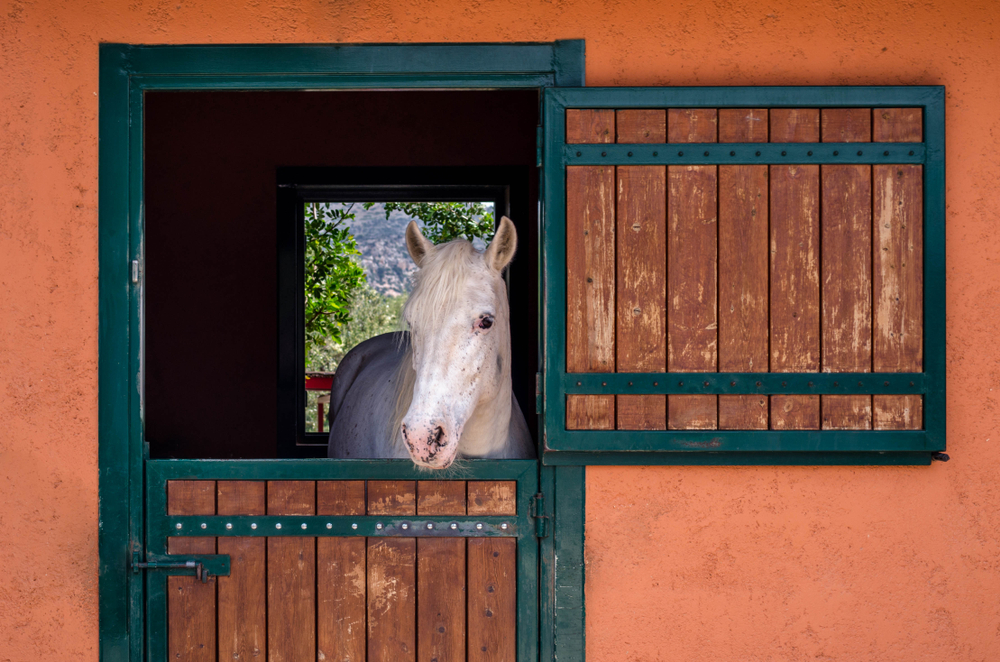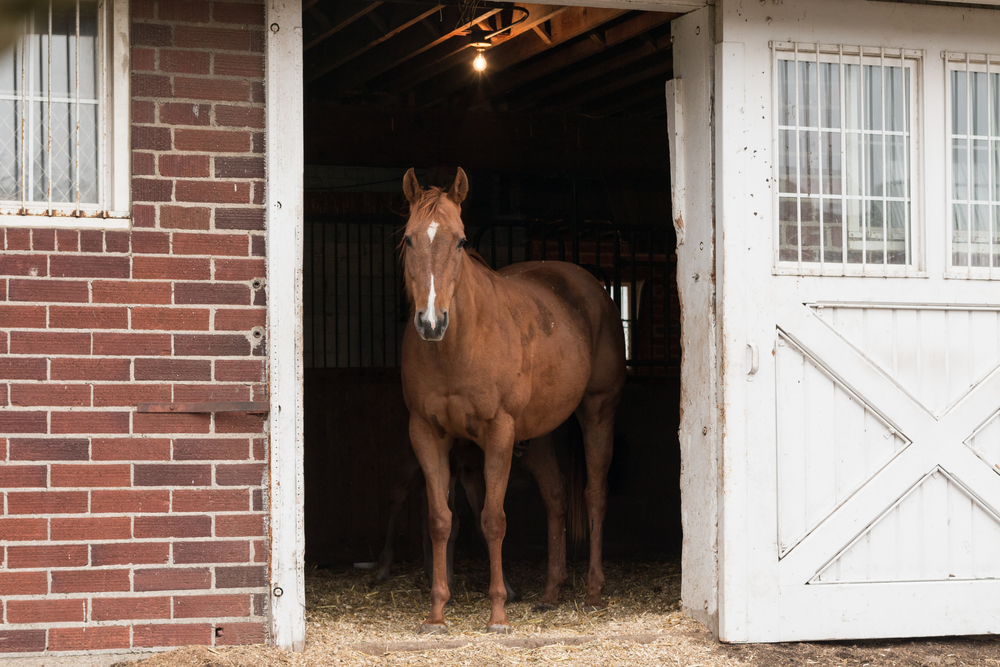
Horse stall doors are essential to a stable, but when designing your stables, a decision that can affect the safety at the barn is whether the stall doors should open in or out. We look at the different ways a stall door should open in this article and discuss them all to help you make the best decision for you and your horse.
When your stable is fitted with swinging stall doors, for safety reasons, they should always open freely to the outside and must always be kept tightly latched down against the stall wall to prevent accidental injuries to your horses. The barn aisle must be wide if stalls doors open to the outside.
There are many questions about horse stall door designs and which way they should open. Horse stall doors have many varieties, but swinging and sliding doors are the most popular. The question is, which way should they open? This article looks at that aspect and safety issues with horse stall doors.
Swinging Horse Stall Doors – The Conundrum
Swinging and hinged horse stall doors are the traditional choices for barn designers, but unfortunately, they are also less practical. Hinged and swinging horse stall doors should always open to the outside into the barn aisle for safety reasons and prevent injuries to your horses.
Because a horse is inside the stable, it is impossible to have the stall door open to the inside with the horse in the stall. Therefore, they open out.
The horse would have to move out of the way for the door to open in. That is not safe or practical for horses who can easily get hurt. For that reason, all swinging horse stall doors open to the outside, away from the horse.
When a swinging horse stall door is opened to the outside, it should always be securely latched. Horses are accident-prone. An unlatched swing door can be blown shut by the wind and cause a horse to spook and run into the door, causing an injury to the horse, or a loose horse in the barn could bump into the half-opened door and get injured.
The result of a horse running into or grazing an unlatched swinging stall door can result in severe injuries to the horse’s hips, stifles, shoulders, neck, eyes, or head.
Swinging or hinged horse stall doors typically use up more space in the barn aisle and complicate opening and closing a horse’s stall. Because these doors swing and open out, they require a barn to have a wide aisle.
Swinging horse stall doors take up even more space when the horse stalls face each other, making them impractical in a multi-horse barn setup.
A Few Helpful Tips When Choosing a Swinging Stall Door
If you are designing a barn and want to use hinged stall doors, it is important to consider aisle width and level in your design.
When choosing a hinged swing stall door, heavy-duty hinges should always be used to prevent sagging later. All horse stall doors should be built to last and be durable with no sharp edges and secure latches.
Considering that you are leading a large horse in or out that can spook easily, all stall door latches should be able to be operated with one hand for quick opening and closing. If you have a horse in hand, this leaves your other hand free to open and close the door easily.
You should also consider installing the stall door latches out of reach of horses. Some horses quickly learn to open stall doors. Most horse stall designs have the stall door positioned in the front and middle of the stall. This position leaves both corners in the stall free and open for hanging water buckets or hay nets.
Stall latches that stick out from the door could cause an injury to your horse as it walks through the door. Always make sure all door latches are oiled regularly and fitted correctly.
A center-placed stall door decreases blind spots in a stall. This is a good example of safe and efficient barn design. A barn aisle must be wide enough to let the swinging stall door open and close smoothly and safely.
When a stall door is left open, make sure it is latched and opened all the way, because when a turned-out horse gets loose and runs back to the barn, he could run into that open stall and squeeze in whether there’s room through the doorway or not and end up with an injury.
You should also remember that the barn aisle must be leveled to facilitate easy door movement when using hinged swinging stall doors. This is essential as the bottom of a horse stall door can get caught and stuck on an uneven barn floor.
When choosing a swinging hinged stall door for your barn, allow a few inches of space between the bottom of the stall door and the barn floor.
No horse owner or handler wants to struggle with a stall door that doesn’t open smoothly and be thrown off balance when dealing with a 1000-pound horse and getting injured.

Sliding Stall Doors – The Practical Solution
Sliding stall doors are the practical solution for horse barns because they slide to open. They are safer than swinging hinged stall doors and take up less space because they do not open into the barn aisle.
Because you can open a sliding stall door just enough to squeeze yourself into the stall without opening a door all the way, they make work around a horse at stable easier than swinging stall doors. Sliding stall doors let a handler adjust the stall’s entrance just wide enough to enter without risking a horse sneak past.
Always make sure that a sliding door is securely latched because horses can learn to open them too.
Sliding stall doors are the best solution for efficiency and safety. Sliding stall doors save time closing and opening doors.
With more than one horse to manage at the barn sliding stall doors are the quickest way to get horses in and out throughout the day; sliding stall doors are simply more practical and efficient than swinging stall doors.
Generally, a sliding stall door should slide to the left, for when you have your horse in your right hand, it leaves your left hand free to open or close the sliding door.
Sliding stall doors are the recommended choice for safety reasons like,
- Sliding stall doors eliminates the chance of unexpectedly slamming closed and spooking a horse.
- Leaving a sliding stall door open gives a stable hand more flexibility and room to do stable chores.
- Sliding doors are more difficult for horses to open or unlatch.
- Sliding doors could be left open when horses are out grazing, making it quick and easy for stable hands or barn managers to count how many horses are in the stalls.
- When leading a horse out or into a stall, sliding doors offer less resistance and time to open.
- Sliding doors are recommended for fire safety. In case of an emergency or a barn fire sliding stall, doors are quick to open; you simply pull the pin latch or push up the latch and slide open the door as you move to the next stall letting the horses out.
- Sliding stall doors allows multiple animals out quickly without creating obstructions in a barn aisle like swinging stall doors.
- Sliding doors are safe and require the least amount of handling.
- Sliding stall doors feature unique styles and designs with curves and tailored designs.
- Sliding stall doors are perfect for a narrow barn aisle that does not have much space.
Conclusion
Hinged swinging stall doors should always open out into the barn aisle. When a swinging stall door is opened, it should always be securely latched to prevent it from slamming or swinging in the wind spooking a horse. Any horse stall door that opens out into the barn aisle can get rammed by a horse passing, causing an injury.
We established that swinging stall doors open out but take up a lot of space and are not very practical in a horse barn.
Multiple stall door designs and styles are available, but the most popular choice is a sliding door because of safety reasons and ease of use. Sliding doors save room as the stall door does not open out into the aisle.
Sliding stall doors are perfect for busy multiple horse barns where horses frequently go out or come in. They are also the best choice when your barn has a narrow aisle.
Whichever stall door you decide to use in your barn, always make sure the door is properly latched and that all the hardware is oiled and functioning properly.
We hope this article was informative and that we have answered your question about whether a horse stall door should open in or out and that this helps you select the right door for your barn.
Sources
- https://blackburnarch.com/2013/07/22/stall-door-design-thoughts-and-tips/
- https://www.middleburglife.com/how-to-select-the-best-stall-doors-for-your-barn/
- https://stablestyle.net/sliding-hinged-stall-doors-horse-barn/
- https://classicequineblog.wordpress.com/2018/01/11/hinge-vs-sliding-stall-front-doors/
